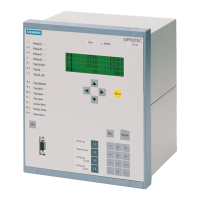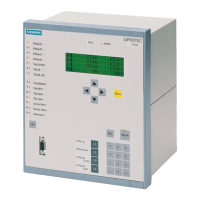Functions
2.39 Inadvertent Energization (ANSI 50, 27)
SIPROTEC, 7UM62, Manual
C53000-G1176-C149-7, Release date 03.2010
268
2.39 Inadvertent Energization (ANSI 50, 27)
The inadvertent energization protection has the task to limit damage caused by the accidental energization of
the stationary or already started, but not yet synchronized generator by quickly actuating the generator circuit
breaker. A connection to a stationary machine is equivalent to connecting to a low-ohmic resistor. Due to the
nominal voltage impressed by the power system, the generator starts up with a high slip as an asynchronous
machine. Thereby inadmissibly high currents are induced in the rotor which could destroy it.
2.39.1 Functional Description
Criteria
The inadvertent energizing protection only intervenes if measured quantities do not yet exist in the valid fre-
quency working area (operational condition 0, with a stationary machine) or if an undervoltage below the
nominal frequency is present (machine already started up, but not yet synchronized). The inadvertent energiz-
ing protection is blocked by a voltage criterion on transgression of a minimum voltage, to prevent it picking up
during normal operation. This blocking is delayed to avoid protection being blocked immediately in the event of
an unintended connection. Another pickup delay is necessary to avoid an unwanted operation during high-
current faults with heavy voltage dip. A dropout time delay allows for a measurement limited in time.
As the inadvertent energizing protection must intervene very rapidly, the instantaneous current values are mon-
itored over a large frequency range already in operational condition 0. If valid measured quantities exist (oper-
ational condition 1), the positive phase-sequence voltage, the frequency for blocking inadvertent energizing
protection as well as the instantaneous current values are evaluated as tripping criterion.
The following figure shows the logic diagram for inadvertent energizing protection. This function can be blocked
via a binary input. For example the existence of the excitation voltage can be used here as an additional crite-
rion. As the voltage is a necessary criterion for enabling the inadvertent energizing protection, the voltage trans-
formers must be monitored. This is done by the Fuse-Failure-Monitor (FFM). If it detects a voltage transformer
fault, the voltage criterion of the inadvertent energizing protection is deactivated.
Figure 2-123 Logic Diagram of the Inadvertent Energizing Protection (Dead Machine Protection)

